|

The
Roman Agora
Lying east of the
Ancient Agora, the Roman Agora
actually has nothing to do with Romans, but took this name
because it was constructed during Roman times -1st century
CE- in order to serve a growing Athens. It is a single architectural complex consisting of a vast
rectangular court, measuring 367 ft
by 315 ft, surrounded by colonnades.
The courtyard was surrounded by stoas, shops and storerooms.
It has an east, Ionic propylon and a west, Doric propylon,
known as the Gate of Athena Archegetis, which linked it to
the Greek Agora. It was built between
19 and 11 BCE with a donation of Julius Caesar and Augustus.
During the reign of Hadrian the court was paved with slabs.
After the invasion of the Herulae in 267 CE, the city of
Athens was restricted to the area within the Late Roman
fortification wall, and the administrative and commercial center
of the city was transferred from the Ancient Agora to the
Roman Agora and the Library of Hadrian.
Click on the thumbnails below in order to see pictures of the Roman Agora.
Use your browser's back button
to return to this page.

|
|
|
|
|
 General
view of the Roman Agora as seen from the east. The Fethiye Djami, a mosque built in 1456
CE by the Turks to celebrate their occupation of Athens, is partially visible on the north side (right). General
view of the Roman Agora as seen from the east. The Fethiye Djami, a mosque built in 1456
CE by the Turks to celebrate their occupation of Athens, is partially visible on the north side (right).
|
|
 General
view of the Roman Agora from the west. The Tower of the Winds
(Horologion of Andronicos) and
the East Propylon are visible in this picture. General
view of the Roman Agora from the west. The Tower of the Winds
(Horologion of Andronicos) and
the East Propylon are visible in this picture.
|
|
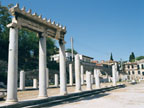 The
East Propylon was the east entrance into the Roman Agora. It had a row of
four Ionic columns made of gray Hymettian marble. It was built in 19-11 BCE. The
East Propylon was the east entrance into the Roman Agora. It had a row of
four Ionic columns made of gray Hymettian marble. It was built in 19-11 BCE. |
|
|
|
|
|
|
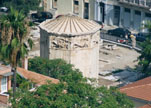
The Tower of the Winds as seen from the Acropolis
with the southwest, south, southeast and east winds visible. The Pentelic marble structure was built in the shape of an octagonal tower with
a pyramidal roof. At the top of the pyramid was a revolving copper
Triton which showed the direction of the wind. The name of the tower comes
from the external friezes, containing carved depictions of the eight winds, each holding a special
symbol, with its name on the cornice: Boreas (north), Skiron (nouthwest), Zephyros (west),
Lips (southwest), Notos
(south), Euros (southeast), Apeliotes (east), and Kaikias (northeast).
Each wind was given a personality according to its characteristics and
each promises different conditions.
|
|
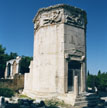 The
east and northeast faces of the Tower of the Winds. Apeliotes (east) is a
young man bringing fruits and grains. Kaikias (northeast) empties a shield
full of icy hailstones on those below. Built in the 1st century BCE by the
Syrian astronomer Andronikos Kyrrestes,
this octagonal structure served as a clepsydra (water-clock), compass and
weather-vane. High up, in the corners on the sides, were iron rods with
carved lines that indicated the hours of the day when it was sunny.
Inside the tower was a water-clock which showed the time when there was
not any sunshine. The clock ran on water from the spring on the Acropolis. The
east and northeast faces of the Tower of the Winds. Apeliotes (east) is a
young man bringing fruits and grains. Kaikias (northeast) empties a shield
full of icy hailstones on those below. Built in the 1st century BCE by the
Syrian astronomer Andronikos Kyrrestes,
this octagonal structure served as a clepsydra (water-clock), compass and
weather-vane. High up, in the corners on the sides, were iron rods with
carved lines that indicated the hours of the day when it was sunny.
Inside the tower was a water-clock which showed the time when there was
not any sunshine. The clock ran on water from the spring on the Acropolis.
|
|
 The
northwest and west faces of the Tower of the Winds. Skiron (northwest)
scatters glowing ashes from a bronze vessel and Zephyros (west) is a semi naked
youth scattering flowers. The
northwest and west faces of the Tower of the Winds. Skiron (northwest)
scatters glowing ashes from a bronze vessel and Zephyros (west) is a semi naked
youth scattering flowers. |
|
|
|
|
|
 The
south, southeast and east faces of the Tower
of the Winds. The tower is located at the eastern end of the Roman Agora.
The tower is well preserved, standing today at over 12 meters (40 feet)
high with a diameter of 8 meters (26 feet). The
south, southeast and east faces of the Tower
of the Winds. The tower is located at the eastern end of the Roman Agora.
The tower is well preserved, standing today at over 12 meters (40 feet)
high with a diameter of 8 meters (26 feet). |
|
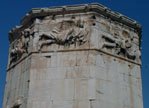 Detail
of the south, southeast and east winds from the Tower of the Winds. Notos
(south) is the bearer of rain, emptying a pitcher of water. Euros
(southeast) is a bearded man, warmly wrapped in a cloak. Apeliotes (east)
is a young man bringing fruits and grain. Detail
of the south, southeast and east winds from the Tower of the Winds. Notos
(south) is the bearer of rain, emptying a pitcher of water. Euros
(southeast) is a bearded man, warmly wrapped in a cloak. Apeliotes (east)
is a young man bringing fruits and grain. |
|
 Detail
of the west, southwest, and south winds from the Tower of the Winds.
Zephyros (west) is a seminaked youth scattering flowers. Lips (southwest)
holds the aphlaston (stern ornament) of a ship as he steers. Notos
(south) is the bearer of rain, emptying a pitcher of water. Detail
of the west, southwest, and south winds from the Tower of the Winds.
Zephyros (west) is a seminaked youth scattering flowers. Lips (southwest)
holds the aphlaston (stern ornament) of a ship as he steers. Notos
(south) is the bearer of rain, emptying a pitcher of water. |
|
|
|
|
|
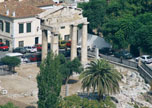 The
Gate of Athena Archegetis as seen from the Acropolis. The monumental
entrance stands on the west side of the Roman Agora. The
Gate of Athena Archegetis as seen from the Acropolis. The monumental
entrance stands on the west side of the Roman Agora. |
|
 The
Gate of Athena Archegetis has a row of four Doric columns and a socle
(base) made
of Pentalic marble. It was built in 11 BCE with the donations of Julius
Caesar and Augustus. The
Gate of Athena Archegetis has a row of four Doric columns and a socle
(base) made
of Pentalic marble. It was built in 11 BCE with the donations of Julius
Caesar and Augustus. |
|
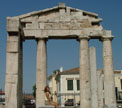 Detail
of the Gate of Athena Archegetis. It was dedicated by the People
(Demos) of Athens to their patroness, Athena Archegetis. Detail
of the Gate of Athena Archegetis. It was dedicated by the People
(Demos) of Athens to their patroness, Athena Archegetis. |
|
|
|
|
|
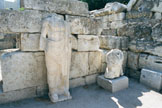 Statues
in the Roman Agora Statues
in the Roman Agora |
|
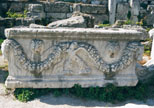 A
tub in the Roman Agora A
tub in the Roman Agora |
|
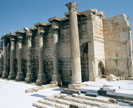 Parallel to the Roman Agora and only 52 feet away is
Hadrian's Library,
built in 132 CE by Emperor Hadrian. It measured 120 x 80 meters (390 x 260
feet). Smaller rooms and a garden with a pool were contained in the
complex in addition to the vast library itself. Parallel to the Roman Agora and only 52 feet away is
Hadrian's Library,
built in 132 CE by Emperor Hadrian. It measured 120 x 80 meters (390 x 260
feet). Smaller rooms and a garden with a pool were contained in the
complex in addition to the vast library itself. |
|
|
|
|
|
© All pictures are Copyright 2000 Grisel Gonzalez and Jeff
Prosise
|